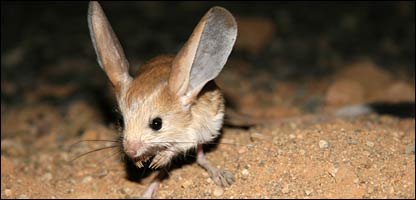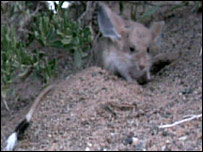First Film of Long-Eared Jerboa
Posted by: Loren Coleman on December 10th, 2007

Long-eared Jerboa (Euchoreutes naso).
An “extraordinary” desert creature has been caught on camera for what scientists believe is the first time.
The long-eared jerboa, a tiny nocturnal mammal that is dwarfed by its enormous ears, can be found in deserts in Mongolia and China.
Zoological Society of London (ZSL) scientist Jonathan Baillie said the footage was helping researchers to learn more about the mysterious animal.
The species is classified as endangered on the IUCN Red list.
The unusual animals were filmed in the Gobi desert during an expedition led by Dr Baillie.Until now, the creatures had proven extremely difficult to study, thanks to their minuscule size, nocturnal nature and the harsh desert environment that they inhabit.
Big ears
Dr Baillie told BBC News that he was “ecstatic” to have tracked down the jerboas.
“These creatures hop just like a kangaroo; it is amazing to watch. Little hairs on their feet, almost like snow shoes, allow them to jump along the sand,” he explained.
“And in terms of mammals, they have one of the biggest ear-to-body ratios out there.”
The footage revealed that the creatures spend daylight hours burrowed down in underground tunnels beneath the sand, and that their diet was mostly made up of insects.
“The long-eared jerboa is a bit like the Mickey Mouse of the desert, cute and comic in equal measure,” Dr Baillie said.
By setting pitfall traps, the researchers were also able to look at the rodents close-up and to begin to estimate their population.
He added that although there was still much to learn about the rare rodent it was already believed to be under threat from habitat disturbance.
“We travelled to the Gobi to find out about the animal’s status and learn more about it so we can develop a thorough long-term action plan.”
Desert bounties
The expedition formed part of ZSL’s Edge programme, which focuses its efforts on conservation plans for animals that are both endangered and evolutionary distinctive.
The long-eared jerboa is one of 10 species that the programme is looking at this year.
Hopping about
“These amazing, remarkable creatures are on the verge of extinction and we know almost nothing about them,” warned Dr Baillie.He added that it was important not to overlook desert habitats in conservation.
“Everyone thinks the desert is a totally desolate area, void of biodiversity, and often when conservation planning is done, deserts are overlooked.
“But there are some remarkable species in the desert, so we really need to start paying attention to this environment.”
An Edge scientist has now been appointed to further study the species. ~ by Rebecca Morelle, BBC News, “Mysterious mammal caught on film.” 10 December 2007.

About Loren Coleman
Loren Coleman is one of the world’s leading cryptozoologists, some say “the” leading living cryptozoologist. Certainly, he is acknowledged as the current living American researcher and writer who has most popularized cryptozoology in the late 20th and early 21st centuries.
Starting his fieldwork and investigations in 1960, after traveling and trekking extensively in pursuit of cryptozoological mysteries, Coleman began writing to share his experiences in 1969. An honorary member of Ivan T. Sanderson’s Society for the Investigation of the Unexplained in the 1970s, Coleman has been bestowed with similar honorary memberships of the North Idaho College Cryptozoology Club in 1983, and in subsequent years, that of the British Columbia Scientific Cryptozoology Club, CryptoSafari International, and other international organizations. He was also a Life Member and Benefactor of the International Society of Cryptozoology (now-defunct).
Loren Coleman’s daily blog, as a member of the Cryptomundo Team, served as an ongoing avenue of communication for the ever-growing body of cryptozoo news from 2005 through 2013. He returned as an infrequent contributor beginning Halloween week of 2015.
Coleman is the founder in 2003, and current director of the International Cryptozoology Museum in Portland, Maine.










The sasquatch brought me here.
But it’s only one of many reasons I stay.
Another cool one. Thanks!
Nocturnal photography using hidden cameras gives everyone hope in a dark world.
I have heard of the jerboa but had no idea they were considered so rare. Not only can they obviously hear an enemy from a mile away, but they have extra long whiskers that run almost the entire length of their body, which they use to feel around in the dark.
The little thing is so adorable, with his big reverse basset hound ears and little puff tail.
Great film footage. That is the cutest little animal I have seen lately. I hope to hear more about it in the future.
Wow! I bet if that lil guy had enough running room, he could fly away. I thought I had big ears. This lil dudes are huge. Kinda reminds me of Dumbo. Cute lil thing anyway.
I want one of those for Christmas
Guess they had to sneak in a camera to catch it on film, with those ears it’d hear you coming from a mile away!
It’s a guy in a mouse costume. Obvious fake.
Cute little thing.
C_STREED:
Heh-heh-heh.
I wholeheartedly agree that the desert ecosystem is given short shrift by many and deserves conservation measures as much as any other environment does. The desert is not a desolate, lifeless place, but is rather full of biodiversity and animals that are quite uniquely adapted to live there. Take this Long-eared jerboa for instance. Can anyone guess why its ears are so amazingly large in contrast to its body?
Answer: Most likely as a way to dissipate body heat in the hot, arid environment. Something that small needs a way to stay cool in such a climate, and exposing as much skin as possible enables them to more effectively do that. Conversely, some Arctic animals have smaller ears for the opposite reason, to retain heat.
The desert is full of similar amazing examples of how different animals have adapted to make this harsh environment their home. To me, it is simply marvelous.
This is the cutest little animal I have seen in a long time! I hope that some of these little guys can be brought into captivity, to a good zoo with excellent breeding programs, to provide some insurance against extinction in the wild due to habitat loss.
Perhaps enough of them could be raised in captivity to eventually allow them to be kept as pets. Other jerboas are kept as pets. If these teeny rabbit-eared fellas could be raised in captivity what enchanting little pets they could make! Of course, there are those who would argue against that idea, but what people come to love, they are more apt to try to save.